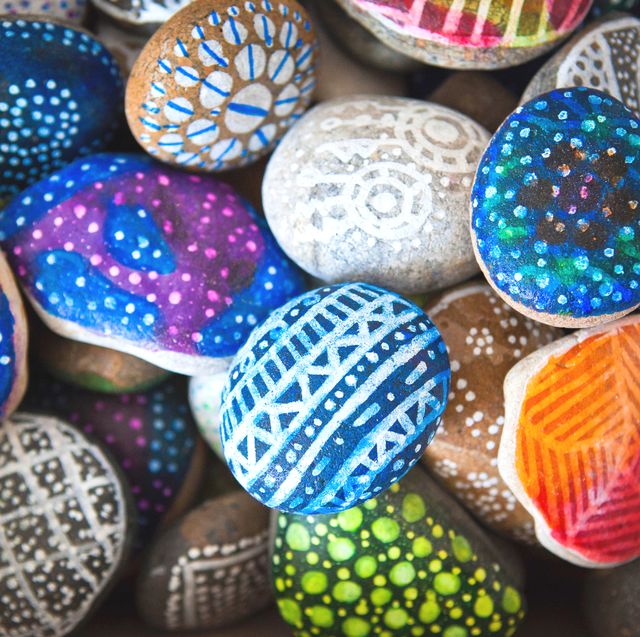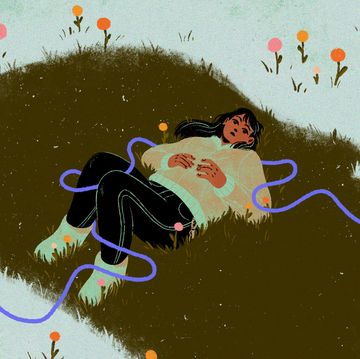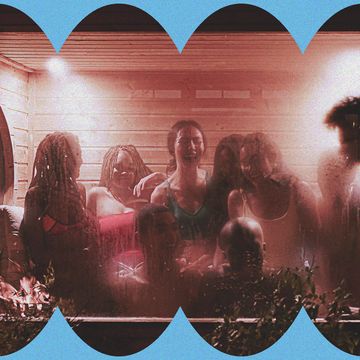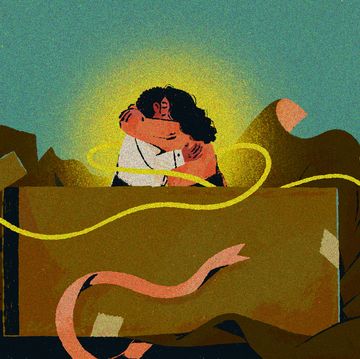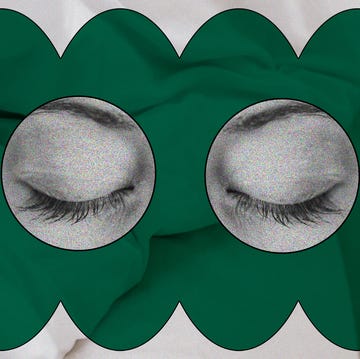If the last few months of upheaval have taught us anything, it’s the importance of taking care of ourselves and each other, both physically and emotionally. From baking to knitting to bathing, we’re taking on as many nurturing rituals as possible to make up for the fact that solace continues to be in short supply.
But the bulk of these rituals, while soothing in nature, don’t quite fill the emotional void that social distancing has created — no matter how many phone calls and Zoom parties we schedule into our all-digital social calendars.
Enter rock painting. On the surface, it sounds like yet another craft project to distract yourself from incessantly worrying. Underneath, however, it’s a whole new (and super-fun) way to reconnect with the outside world.
How rock painting is bringing communities together during self-isolation
Painting rocks may have become popular over the last several years, but the practice has actually been around for thousands.
“As far as I know, painted pebbles date from the period of the late Ice Age and beginning of the Holocene,” says Ingo Kraft, head of the Archaeological Heritage Office in Dresden, Germany. “This means they’re about 12-15,000 years old.” The exact meaning behind them, however, still remains a mystery.
Flash forward to 2015, when painted pebbles were given a renewed sense of purpose by Megan Murphy, a Massachusetts-based women’s empowerment coach who founded The Kindness Rocks Project as a meaningful way to give back to her community.
Her mission is brilliant in its simplicity: decorate rocks with vibrant designs and inspiring messages, mark them with a distinguishing hashtag, and scatter them around your neighborhood to uplift the people who find them.
Whoever finds a rock can take a photo of it and use the hashtag to connect with other rock painting enthusiasts on social media. They can either replace the rock with one they’ve painted or hide the one they found in a new spot.
Kindness rocks have been a worldwide phenomenon ever since, with rock painting seeing another surge in popularity since the start of the pandemic. “Mindfulness and creativity are both important components of art therapy, and so many are turning to this as a way to manage their anxiety and stress right now,” says Murphy.
“I also believe our empathy towards one another has increased as a result of this pandemic, and with that, people are looking for ways to connect and lend a hand or a kind word or offer a gesture that lets people know they’re not alone,” she adds.
Why rock painting is such a relaxing and fulfilling ritual
“When we engage in activities, like rock painting, that require our focus in a gentle, mindful way, we benefit on both psychological and physical levels,” says Carla Marie Manly, a California-based clinical psychologist and author of Joy From Fear.
The process of mapping out a pebble design and executing your masterpiece keeps your mind focused on the task at hand, distracting it from outside stressors and temporarily relieving anxiety and worries for the future. “On a neurobiological level, calm-inducing GABA (gamma aminobutyric acid) levels increase when engaging in mindfulness-based tasks,” says Manly.
The mind and body also benefit from increased levels of serotonin, a feel-good neurochemical, as well as dopamine, which is often called the brain’s reward neurochemical.
“When a creative activity feels soothing, the parasympathetic nervous system serves to reduce stress hormones, and a sense of calm floods the body,” says Manly.
And the stress-relieving chemicals keep coming even after you’re done painting. Much like the “high” experienced after a refreshing yoga class, a sense of “wow” often happens after completing an artistic task. “Endorphins, the body’s natural feel-good chemicals, tend to flood the body when we’ve accomplished something important,” says Manly.
The zen-like state that follows up the completion of a creative project can translate into increased positivity and greater self-confidence, she adds. When we feel more positive and confident, we tend to transfer this positive state into other arenas of life, such as how we handle stress and interact with others.
Then there’s the process of hiding of your painted rocks around the community, which activates more reward chemicals. “The creator and giver benefits when dopamine levels rise due to the anticipation of being rewarded — the anticipatory joy that comes with knowing that someone’s day will be brightened when they come across your kindness rock,” says Manly.
The person who finds your surprise gift might experience a surge of mood-boosting neurochemicals, since having a sense of community is foundational for feelings of safety and security. They not only connect with the message you’ve put out into the world, but realize another person created that rock specifically to lift them up.
The result? They feel understood and less alone. “A connection is made with another human being even though you’ve never met,” says Murphy. “It’s a magical process, and all through a simple rock.”
How to start your own rock painting practice
Find smooth, flat rocks
Depending on where you live, you can scavenge outside for them, or you can purchase them from garden centers, hardware stores and craft shops. River rocks around three to six inches in size typically work best. (Because they’re in such high demand, bags of river rocks might be tricky to find online at the moment, so Murphy suggests making your own using Cement All and silicone soap molds.)
Stock up on supplies
The basic art supplies you’ll need include non-toxic acrylic paint for the base coat of your rocks (like Apple Barrell or FolkArt), pencils for sketching (BIC), paint brushes and palettes (Royal Brush, Winsor & Newton, Floranea), fine point paint pens or markers for the artwork and lettering (Artistro, Faber-Castell, Sakura), and a clear topcoat sealant (Krylon, Mod Podge) to protect your masterpiece and the environment.
Join a local rock painting group
If you’d like to join a rock painting group in your area, The Kindness Rocks Project has a map on their website you can use to hunt one down, says Murphy. You can also search USA Painted Rocks, a Facebook group dedicated specifically to matching people up with local rock painting groups, or find a group near you by Googling “your-town your-state painted rocks” (sans quotation marks).
Choose your design
From books (Rock Art Handbook, Rock Painting For Beginners, The Little Book of Rock Painting) to blogs (Color Made Happy, Paint Happy Rocks, The Kindness Rocks Project), to YouTube videos to hashtags (#rockpainting, #paintedrocks), there’s no shortage of rock painting inspiration and how-tos online.
“In choosing inspiration for your rock, if you think about the message that you’d like to find yourself and put that message on your rock, you’ll find a greater connection to the craft,” says Murphy. “This helps you check in with yourself and becomes a great mindfulness practice.” Not to mention, connect with others who find your rock and might need the words just as much as you do.
Get your paint on
Once you’ve decided on a design, start by painting a base coat on your rock. “The best colors for base coating are blue, purple, or green,” says Murphy. “They have pigments in them where you’ll only need one coat, whereas other colors need multiple coats for coverage.”
To ensure the proportions of your design are correct, pencil it on first and make necessary adjustments before setting paint pen to rock.
Use your paint pens or markers to set your design in stone (no pun intended), then let it dry for an hour or so before clear coating your masterpiece.
Oh, and don’t forget to add a hashtag to the back of your rocks so you can keep tabs on who your artwork has impacted and the different places your rocks have travelled to.
You can create your own hashtag, or you can use hashtags already set in motion by other rock painting enthusiasts, such as #thekindnessrocksproject and #painthappy, or the hashtags used by your local rock painting groups.
If you’re using a paint-on sealer, make sure your artwork is completely dry first to prevent smearing or smudging. If using a spray sealer, spray it on from a distance of two to three feet away to keep your artwork from running.
“Several light coats work best,” says Murphy, who recommends sealing your rock in a well-ventilated area while wearing a face mask (you may have heard of them).
Brighten someone’s day
You can give the rock to someone specific (a delivery person, neighbor, or relative), or you can leave them around your neighborhood for someone else to find — preferably, where there’s quite a bit of foot traffic for it to get noticed (say, on a park bench or outside a community center).
“We’ve also been creating kindness rock gardens where people can ‘plant’ them in their community and ‘grow’ kindness,” says Murphy. “It’s a great way to get the entire community involved.”
But you don't want to just leave your painted rocks anywhere. Murphy recommends educating yourself on The 7 Principles of Leave No Trace, an organization dedicated to protecting the outdoors by teaching us how to enjoy responsibly.
“Even if the intent is to spread inspiration and kindness, leaving your painted rocks in national parks and forests isn’t okay,” she says. Ditto for outside businesses or on private property — always seek the owner’s permission in advance.
To start a rock-painting community in your area, choose (and score approval) for a location, then add an instructional sign that reads: “Take one if you need one or share one with someone who needs some inspiration or join us and add one to the garden to help us grow love.” Plant a handful of painted rocks to get things going and watch your garden "bloom."
Krissy Brady covers women's health and wellness.
Get Shondaland directly in your inbox: SUBSCRIBE TODAY
